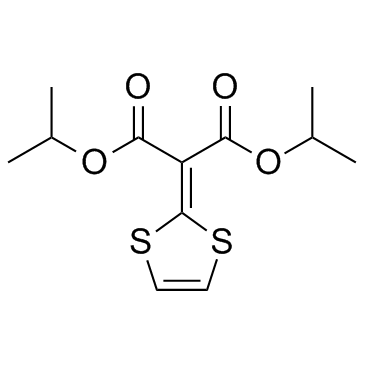
Malotilate
CAS No. 59937-28-9
Malotilate( Malotilate | CL-1500 | NKK 105 | NKK-105 )
Catalog No. M15231 CAS No. 59937-28-9
Malotilate, diisopropyl 1,3-dithiol-2-ylidenemalonate, is a drug used for the treatment of liver cirrhosis.
Purity : >98% (HPLC)
 COA
COA
 Datasheet
Datasheet
 HNMR
HNMR
 HPLC
HPLC
 MSDS
MSDS
 Handing Instructions
Handing Instructions
| Size | Price / USD | Stock | Quantity |
| 5MG | 41 | In Stock |


|
| 10MG | 65 | In Stock |


|
| 25MG | 82 | In Stock |


|
| 50MG | 110 | In Stock |


|
| 100MG | 178 | In Stock |


|
| 200MG | 232 | In Stock |


|
| 500MG | Get Quote | In Stock |


|
| 1G | Get Quote | In Stock |


|
Biological Information
-
Product NameMalotilate
-
NoteResearch use only, not for human use.
-
Brief DescriptionMalotilate, diisopropyl 1,3-dithiol-2-ylidenemalonate, is a drug used for the treatment of liver cirrhosis.
-
DescriptionMalotilate, diisopropyl 1,3-dithiol-2-ylidenemalonate, is a drug used for the treatment of liver cirrhosis.(In Vitro):Malotilate reduces collagen synthesis and cell migration activity of fibroblasts in vitro.Malotilate, an anti-fibrotic substance, selectively inhibited the 5-lipoxygenase, whereas both the 12- and the 15-lipoxygenase pathways are stimulated. Malotilate has been shown to prevent acute experimental liver injury induced by several hepatotoxic compounds, including Ahyl alcohot, Bromobenzene, Carbon tetrachloride, ChIoroform, Dimethylnitrosamine and Thioacetamide.(In Vivo):Malotilate (100 mg/kg; p.o.; daily for 3 days) treatment in rats with hypocholesterolemia results in a rapid normalization of lowered serum cholesterol.
-
In VitroMalotilate reduces collagen synthesis and cell migration activity of fibroblasts in vitro.Malotilate, an anti-fibrotic substance, selectively inhibited the 5-lipoxygenase, whereas both the 12- and the 15-lipoxygenase pathways are stimulated. Malotilate has been shown to prevent acute experimental liver injury induced by several hepatotoxic compounds, including Ahyl alcohot, Bromobenzene, Carbon tetrachloride, ChIoroform, Dimethylnitrosamine and Thioacetamide.
-
In VivoMalotilate (100 mg/kg; p.o.; daily for 3 days) treatment in rats with hypocholesterolemia results in a rapid normalization of lowered serum cholesterol. Animal Model:Male rats of the SLC-SD strain (rats with carbon tetrachloride-induced liver damage)Dosage:100 mg/kg Administration:P.o.; daily for 3 days Result:The triglyceride secretion from livers in rats given CCI4 was inhibited to about 40% of the level in the control rats. This inhibition of the triglyceride secretion was completely normalized in response to malotilate administration for 3 days.
-
SynonymsMalotilate | CL-1500 | NKK 105 | NKK-105
-
PathwayOthers
-
TargetOther Targets
-
RecptorOthers
-
Research AreaCancer
-
Indication——
Chemical Information
-
CAS Number59937-28-9
-
Formula Weight288.38
-
Molecular FormulaC12H16O4S2
-
Purity>98% (HPLC)
-
SolubilityEthanol: 58 mg/mL (201.12 mM); DMSO: 58 mg/mL (201.12 mM)
-
SMILESO=C(OC(C)C)/C(C(OC(C)C)=O)=C1SC=CS/1
-
Chemical Name1,3-Dithiol-2-ylidenepropanedioic acid, bis(1-methylethyl) ester
Shipping & Storage Information
-
Storage(-20℃)
-
ShippingWith Ice Pack
-
Stability≥ 2 years
Reference
1.Ohgoda O, et al. J Dermatol Sci, 1998, 17(2), 123-13
molnova catalog



related products
-
5-Hydroxy-4a,8-dimet...
The herbs of Inula hupehensis.
-
Methyl mycophenolate
Methyl mycophenolate is found in the marine fungus Phaeosphaeria spartinae. Methyl mycophenolate is the methyl ester form of mycophenolic acid.
-
Speract TFA(76901-59...
Speract TFA is a sea urchin egg peptide that regulates sperm motility, also stimulates sperm mitochondrial metabolism.The stimulation of sperm with speract depolarizes the mitochondrion and increases the levels of NADH.?Surprisingly, these responses are independent of external Ca(2+) and are due to the increase in intracellular pH (pHi) induced by speract.?



 Cart
Cart
 sales@molnova.com
sales@molnova.com


